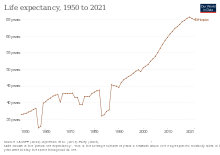

Health in Ethiopia has improved markedly since the early 2000s, with government leadership playing a key role in mobilizing resources and ensuring that they are used effectively. A central feature of the sector is the priority given to the Health Extension Programme, which delivers cost-effective basic services that enhance equity and provide care to millions of women, men and children. The development and delivery of the Health Extension Program, and its lasting success, is an example of how a low-income country can still improve access to health services with creativity and dedication.[1]
The Human Rights Measurement Initiative finds that Ethiopia is fulfilling 83.3% of what it should be fulfilling for the right to health based on its level of income.[2] When looking at the right to health with respect to children, Ethiopia achieves 94.5% of what is expected based on its current income.[2] In regards to the right to health amongst the adult population, the country achieves only 90.6% of what is expected based on the nation's level of income.[2] Ethiopia falls into the "very bad" category when evaluating the right to reproductive health because the nation is fulfilling only 64.8% of what the nation is expected to achieve based on the resources (income) it has available.[2]
- ^ Good Health at Low Cost. 25 years on: What Makes A Successful Health System? Balabanova et al, London School of Hygiene and Tropical Medicine, 2011
- ^ a b c d "Ethiopia - HRMI Rights Tracker". rightstracker.org. Retrieved 17 March 2022.
© MMXXIII Rich X Search. We shall prevail. All rights reserved. Rich X Search
